
CURATOR’s EYE
ishii-nobuo: A late blooming wonder, bringing smiles to the world.
Follow TRiCERA on Instagram and check out our creative artists
5%OFF & free shipping 1st purchase
FIRSTART5
10%OFF 2nd purchase after 1st purchase!
Welcome to TRiCERA
Hi there! We are pleased to have you here 🎉
Could you please describe yourself?
Guest
Van Gogh, Gauguin, and other painters are constantly exhibited throughout Japan.
In fact, they are the "Post-Impressionists," or "Post-Impressionist" painters.
In this issue, we will explain the background of 10 famous Post-Impressionist painters and their works.
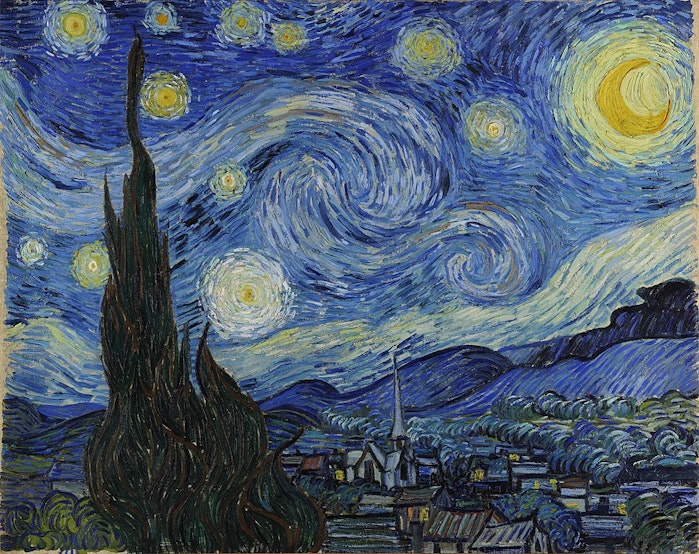
Collection of the Museum of Modern Art (MoMA), New York
Vincent van Gogh was famous for his genius and premature death, but he is also known to have suffered from mental illness.
In 1888, while living with the painter Gauguin in Arles, France, Van Gogh's various quarrels and frustrations exploded, resulting in the famous ear-slicing incident.
After the ear-slicing incident, Van Gogh decided to be admitted to a mental hospital, Hospital Saint-Paul-de-Mausole, where he was diagnosed with "acute mania with generalized delirium.
Fortunately for him, he was able to continue his creative work during his hospitalization. He spent his days gazing out of his iron barred window at the view below. It was here that he completed his most famous work, "Starry Moonlit Night.
Starry Moonlit Night" was painted at different times of the day. Sunrise, moonrise, sunny days, cloudy days, windy days, rainy days, etc., he painted this faithfully as he watched the light and weather change.
Although this work is recognized as a masterpiece, Van Gogh was never satisfied with it and reportedly said that he considered the other works he completed while hospitalized to be failures as well.
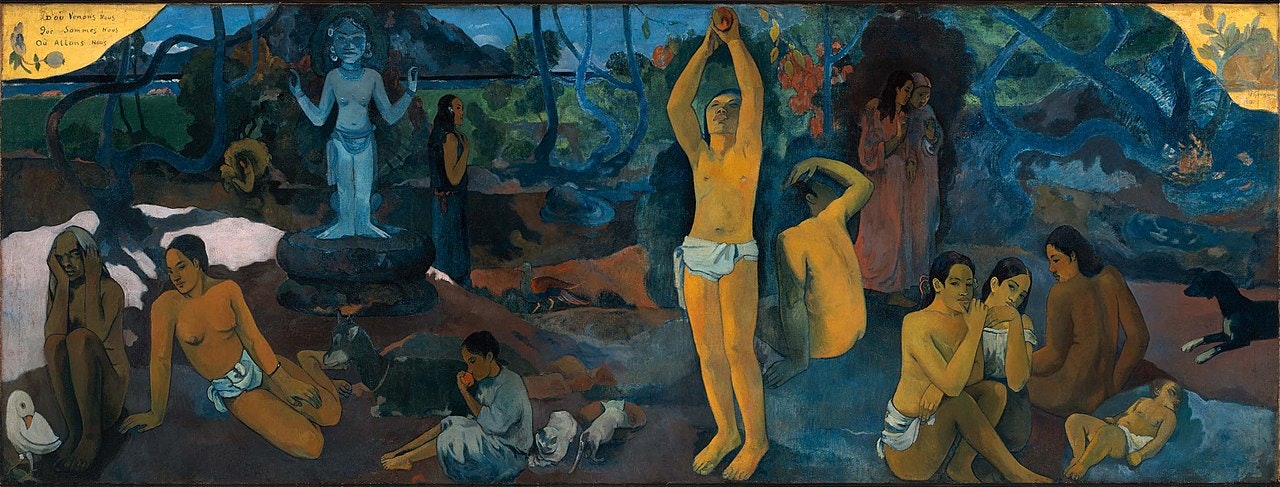
Collection of the Museum of Fine Arts, Boston
While working on "Where We Came From, Who We Are, Where We Are Going," Gauguin was struck by a number of major life-changing events.
Gauguin, who was unaccustomed to the tropical environment, suffered from dermatitis and eczema, as well as syphilis and conjunctivitis.
In addition, his financial situation was deteriorating rapidly, and he began to run up debts.
When his family in Copenhagen informed him of his daughter's death, Gauguin was devastated.
In the fall of 1897, after finishing "Where We Came From," Gauguin was struck by the death of his daughter. At the time, his family had moved to Copenhagen, and the death of his beloved daughter was a particular shock to Gauguin, who had been doing whatever he pleased without regard for his family.
The theme of life being born and life being lost is also expressed in this painting.
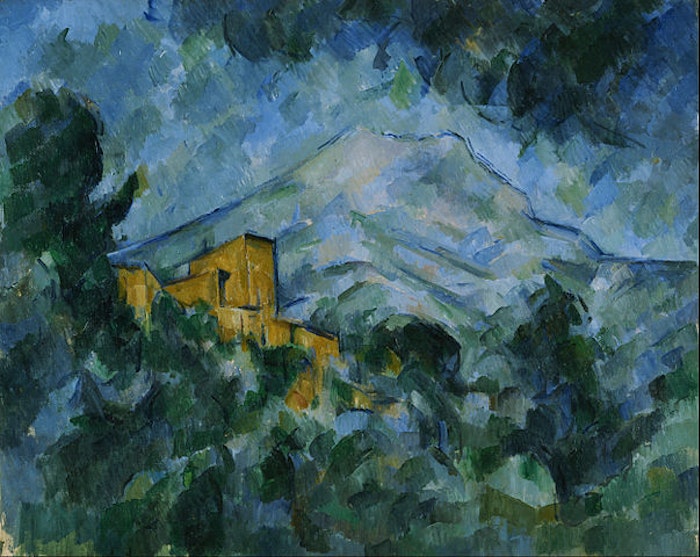
Collection of the Musée d'Artizon
Cézanne attempted to go beyond the Impressionist paintings that tried to capture on canvas the fleeting glimmer of the eye, to paintings with a robust sense of volume that would remain strong enough to endure indefinitely.
It was an extremely difficult task to capture the opposites in the same picture plane, and it was a continuous process of trial and error for the artist.
To accomplish this, Cézanne chose to work in solitude, away from his fellow Impressionists, and to achieve this goal by repeating a few fixed subjects.
In the late 1880s, he began painting a series of images of Mount Sainte-Victoire, a calcareous mountain rising in the east of his native Aix-en-Provence in southern France.
Eventually, these images became highly refined works of art, supported by vivid colors that added a sense of movement and vibration to the solid surface. This work is the culmination of his experimentation.
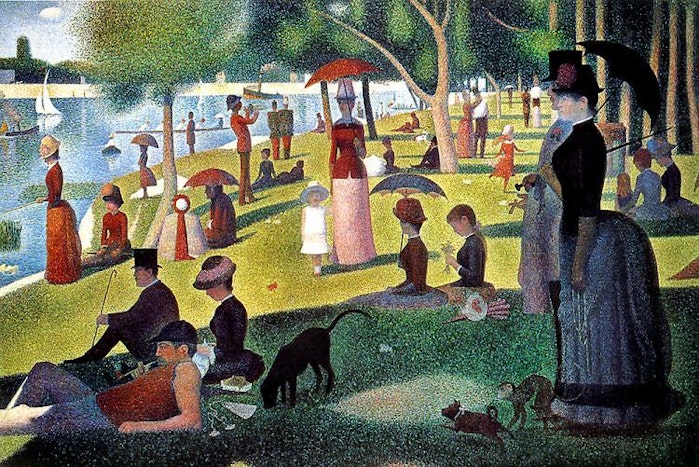
Collection of The Art Institute of Chicago
Georges Seurat, one of the Post-Impressionist painters known as the Neo-Impressionists, is famous for developing the pointillism technique.
Dotting is a technique that uses a collection of dots or very short touches rather than lines, and was conceived in reference to the way light was captured on the retina as revealed by research into optics at the time.
This technique ultimately promoted the method of "creating bright shadow colors without mixing paints" created by the Impressionists, and expanded the range of expression in painting.
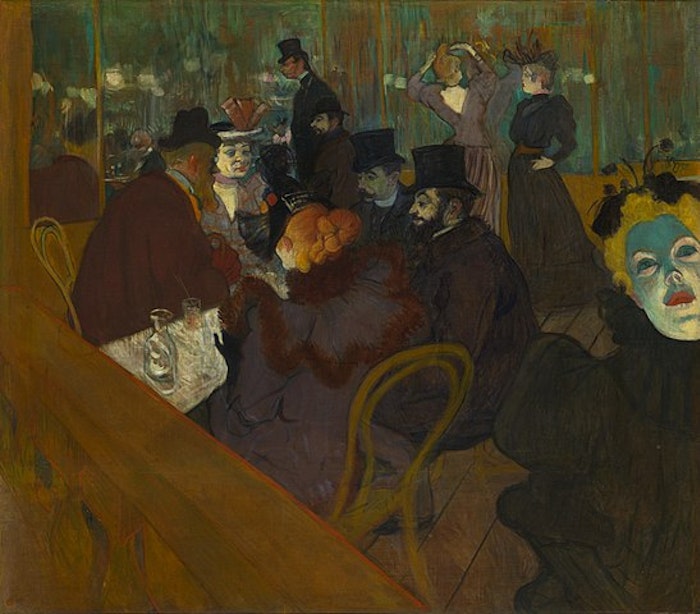
The Art Institute of Chicago
In this oil painting of people dancing at the Moulin Rouge cabaret, Lautrec's own self-portrait is painted in a corner of the background.
Near the center of the painting is a group of three men and two women seated around a table on the floor of the cabaret.
From right to left are writer Edouard Dujardin, dancer La Macarona, photographer Paul Secaux, photographer Maurice Guibert, and, across from them, Jane Abril, whose reddish-orange hair identifies her as the central figure in this group.
In the right foreground is a portion of the face of May Milton, an English dancer who appears to be seated at another table, her lips painted red and her face glowing with a distinctive greenish light and shadow.
Fixing her hair on the right side of the background are Moulin Rouge dancer La Grue and another woman. In the center-left background, standing in front of and next to Dr. Gabrielle Tapier de Serein, is Toulouse-Lautrec himself, a short man whose growth was halted by a broken leg as a child.
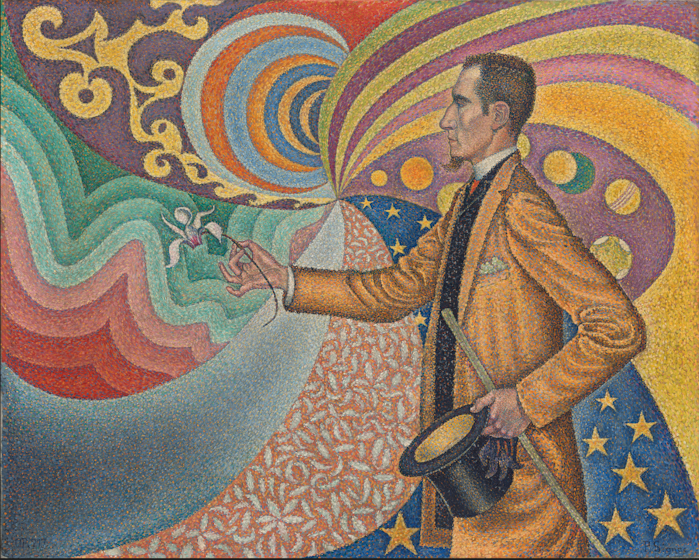
1890|Museum of Modern Art (MoMA), New York
Félix Fénéon was an editor, translator, art dealer, anarchist activist, and critic who in the late 1880s used the term neo-impressionism to describe the works of Signac and Seurat.
In this portrait, Signac depicts Féneon in left profile.
The relationship between Féneon and the background ornamentation is considered symbolic.
In 1887, Féneon wrote in defense of the neo-impressionists against criticism that their pointillist paintings resembled mosaics or tapestries.
He wrote: "Take a few steps backward, and the technique disappears. The technique disappears, and the eye is drawn to nothing but the essence of the painting."
But what was the essence of painting at this time?
Was it a means of conveying to the viewer the transience of nature, or was it a technique of putting paint on canvas? In this portrait, the answer is both and neither.
Fénéon's idea of painting was to create a superior, purified reality infused with the artist's personality.
.png?w=700&h=897)
Collection of the Museum of Modern Art (MoMA), New York
Odilon Redon was an individualist who believed in the primacy of imagination over observation of nature, and rejected the realism and impressionism of his contemporaries in favor of a more personal view of art.
He studied academic painting in Paris, but was disappointed with academism and began making copperplate prints in his hometown of Bordeaux in 1864.
There, Redon found lithography a technique that enabled him to achieve infinite tonal gradations, delicate linework, and rich light and dark depictions.
During his lifetime, Redon produced nearly 30 etchings and 200 lithographs, mostly in black and white. He was greatly inspired by writers such as Edgar Allan Poe and Gustave Flaubert. Impressed by Flaubert's 1874 prose poem "The Temptation of St. Anthony," Redon created three works based on this poem, one of which is shown here.
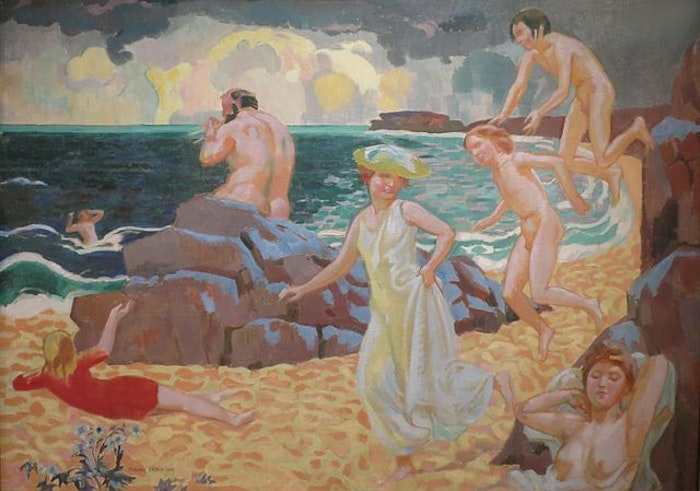
1907, Collection of the Pushkin Museum of Fine Arts
Denis is famous as a central Symbolist painter.
He focused on the flatness of painting, which later came to be recognized as the starting point of modernism.
In his 1890 article "The Definition of Neotraditionalism,
In his 1890 article, "The Definition of the New Traditionalism," he famously said, "It should be recalled that a painting is essentially a flat surface covered with colors collected in a certain order, before it is a warhorse, a nude woman, or an anecdote of some kind.
He left us with these famous words.
This work was exhibited in the last years of his life, and is in the neoclassical technique, with a style that promotes more mythological and missiological elements.
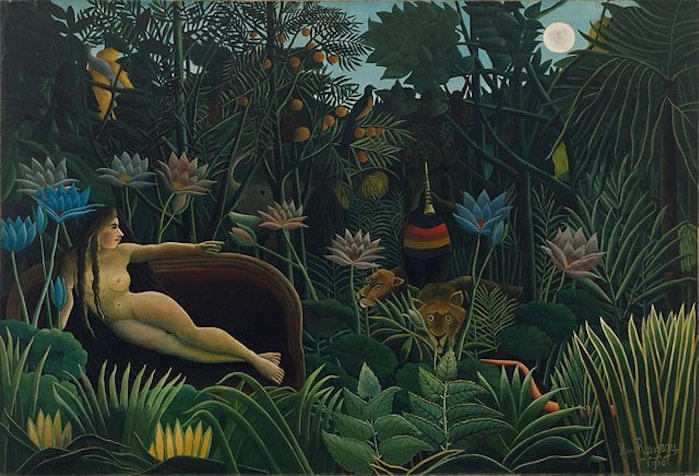
1910, Museum of Modern Art (MoMA), New York
This is one of more than 25 paintings by Rousseau on the theme of the jungle.
It was the last work Rousseau produced before his death on September 2, 1910.
Rousseau incorporated large tropical plants with large leaves into the painting, which he sketched in the botanical garden in the Paris Museum of Natural History. The nude woman's left arm extends toward the lions and the black snake charmer, who faces forward in the center of the picture and plays a vertical flute, barely visible in the jungle gloom under the dim light of the full moon.
A pink snake glides through the undergrowth.
The painting was accompanied by a poem titled "Dedication to 'Dreams.
Jadwiga in her beautiful dream
Sleeping peacefully
I heard the sound of an orthodox magician's
I heard the sound of a vertical flute
The flowers and the lush trees
The moon shone on flowers and lush trees
The beasts and snakes
listened to the music of the vertical flute.
.jpg?w=700&h=868)
Oslo Museum of Art
This oil painting is synonymous with Munch.
In fact, there are also "The Scream" painted in other materials such as pastels, lithographs, and tempera, making a total of five "Scream" works.
The work features a figure with an extremely deformed and distinctive touch, a blood-red fjord evening scene with eerie shapes, a dark background contrasting with the red sky, and an excellent composition that emphasizes perspective.
When Munch first published this painting, it was heavily criticized by critics of the time, but later turned around and was highly acclaimed.
In 1978, American art historian Robert Rosenblum theorized that a Peruvian mummy on display at the Museum of Human History in Paris, France, was the model for the central figure in The Scream.
In fact, the mummy has much in common with the figure in "The Scream," including round, sunken eyes, an open mouth, a hand on the cheek, and a thin body.
In 2004, an Italian anthropologist speculated that the mummy was modeled on one seen in the Natural History Museum in Florence. This mummy has further similarities to the painting, but this section has been disputed because Munch would not have visited Florence until after he painted The Scream.
View TRiCERA ART's latest works
TRiCERA ART members receive a variety of benefits and preferences.
- Discounts, including members-only secret sales and coupons
- Create My Collection by registering your favorite artists
- Receive updates on popular artists, exhibitions, and events
- Receive a weekly newsletter with selected art
- Personal Assessment to find out what kind of art you like.
Please register for free to receive the latest information.

Writer
TRiCERA ART
Van Gogh, Gauguin, and other painters are constantly exhibited throughout Japan.
In fact, they are the "Post-Impressionists," or "Post-Impressionist" painters.
In this issue, we will explain the background of 10 famous Post-Impressionist painters and their works.

Collection of the Museum of Modern Art (MoMA), New York
Vincent van Gogh was famous for his genius and premature death, but he is also known to have suffered from mental illness.
In 1888, while living with the painter Gauguin in Arles, France, Van Gogh's various quarrels and frustrations exploded, resulting in the famous ear-slicing incident.
After the ear-slicing incident, Van Gogh decided to be admitted to a mental hospital, Hospital Saint-Paul-de-Mausole, where he was diagnosed with "acute mania with generalized delirium.
Fortunately for him, he was able to continue his creative work during his hospitalization. He spent his days gazing out of his iron barred window at the view below. It was here that he completed his most famous work, "Starry Moonlit Night.
Starry Moonlit Night" was painted at different times of the day. Sunrise, moonrise, sunny days, cloudy days, windy days, rainy days, etc., he painted this faithfully as he watched the light and weather change.
Although this work is recognized as a masterpiece, Van Gogh was never satisfied with it and reportedly said that he considered the other works he completed while hospitalized to be failures as well.

Collection of the Museum of Fine Arts, Boston
While working on "Where We Came From, Who We Are, Where We Are Going," Gauguin was struck by a number of major life-changing events.
Gauguin, who was unaccustomed to the tropical environment, suffered from dermatitis and eczema, as well as syphilis and conjunctivitis.
In addition, his financial situation was deteriorating rapidly, and he began to run up debts.
When his family in Copenhagen informed him of his daughter's death, Gauguin was devastated.
In the fall of 1897, after finishing "Where We Came From," Gauguin was struck by the death of his daughter. At the time, his family had moved to Copenhagen, and the death of his beloved daughter was a particular shock to Gauguin, who had been doing whatever he pleased without regard for his family.
The theme of life being born and life being lost is also expressed in this painting.

Collection of the Musée d'Artizon
Cézanne attempted to go beyond the Impressionist paintings that tried to capture on canvas the fleeting glimmer of the eye, to paintings with a robust sense of volume that would remain strong enough to endure indefinitely.
It was an extremely difficult task to capture the opposites in the same picture plane, and it was a continuous process of trial and error for the artist.
To accomplish this, Cézanne chose to work in solitude, away from his fellow Impressionists, and to achieve this goal by repeating a few fixed subjects.
In the late 1880s, he began painting a series of images of Mount Sainte-Victoire, a calcareous mountain rising in the east of his native Aix-en-Provence in southern France.
Eventually, these images became highly refined works of art, supported by vivid colors that added a sense of movement and vibration to the solid surface. This work is the culmination of his experimentation.

Collection of The Art Institute of Chicago
Georges Seurat, one of the Post-Impressionist painters known as the Neo-Impressionists, is famous for developing the pointillism technique.
Dotting is a technique that uses a collection of dots or very short touches rather than lines, and was conceived in reference to the way light was captured on the retina as revealed by research into optics at the time.
This technique ultimately promoted the method of "creating bright shadow colors without mixing paints" created by the Impressionists, and expanded the range of expression in painting.

The Art Institute of Chicago
In this oil painting of people dancing at the Moulin Rouge cabaret, Lautrec's own self-portrait is painted in a corner of the background.
Near the center of the painting is a group of three men and two women seated around a table on the floor of the cabaret.
From right to left are writer Edouard Dujardin, dancer La Macarona, photographer Paul Secaux, photographer Maurice Guibert, and, across from them, Jane Abril, whose reddish-orange hair identifies her as the central figure in this group.
In the right foreground is a portion of the face of May Milton, an English dancer who appears to be seated at another table, her lips painted red and her face glowing with a distinctive greenish light and shadow.
Fixing her hair on the right side of the background are Moulin Rouge dancer La Grue and another woman. In the center-left background, standing in front of and next to Dr. Gabrielle Tapier de Serein, is Toulouse-Lautrec himself, a short man whose growth was halted by a broken leg as a child.

1890|Museum of Modern Art (MoMA), New York
Félix Fénéon was an editor, translator, art dealer, anarchist activist, and critic who in the late 1880s used the term neo-impressionism to describe the works of Signac and Seurat.
In this portrait, Signac depicts Féneon in left profile.
The relationship between Féneon and the background ornamentation is considered symbolic.
In 1887, Féneon wrote in defense of the neo-impressionists against criticism that their pointillist paintings resembled mosaics or tapestries.
He wrote: "Take a few steps backward, and the technique disappears. The technique disappears, and the eye is drawn to nothing but the essence of the painting."
But what was the essence of painting at this time?
Was it a means of conveying to the viewer the transience of nature, or was it a technique of putting paint on canvas? In this portrait, the answer is both and neither.
Fénéon's idea of painting was to create a superior, purified reality infused with the artist's personality.
.png?w=700&h=897)
Collection of the Museum of Modern Art (MoMA), New York
Odilon Redon was an individualist who believed in the primacy of imagination over observation of nature, and rejected the realism and impressionism of his contemporaries in favor of a more personal view of art.
He studied academic painting in Paris, but was disappointed with academism and began making copperplate prints in his hometown of Bordeaux in 1864.
There, Redon found lithography a technique that enabled him to achieve infinite tonal gradations, delicate linework, and rich light and dark depictions.
During his lifetime, Redon produced nearly 30 etchings and 200 lithographs, mostly in black and white. He was greatly inspired by writers such as Edgar Allan Poe and Gustave Flaubert. Impressed by Flaubert's 1874 prose poem "The Temptation of St. Anthony," Redon created three works based on this poem, one of which is shown here.

1907, Collection of the Pushkin Museum of Fine Arts
Denis is famous as a central Symbolist painter.
He focused on the flatness of painting, which later came to be recognized as the starting point of modernism.
In his 1890 article "The Definition of Neotraditionalism,
In his 1890 article, "The Definition of the New Traditionalism," he famously said, "It should be recalled that a painting is essentially a flat surface covered with colors collected in a certain order, before it is a warhorse, a nude woman, or an anecdote of some kind.
He left us with these famous words.
This work was exhibited in the last years of his life, and is in the neoclassical technique, with a style that promotes more mythological and missiological elements.

1910, Museum of Modern Art (MoMA), New York
This is one of more than 25 paintings by Rousseau on the theme of the jungle.
It was the last work Rousseau produced before his death on September 2, 1910.
Rousseau incorporated large tropical plants with large leaves into the painting, which he sketched in the botanical garden in the Paris Museum of Natural History. The nude woman's left arm extends toward the lions and the black snake charmer, who faces forward in the center of the picture and plays a vertical flute, barely visible in the jungle gloom under the dim light of the full moon.
A pink snake glides through the undergrowth.
The painting was accompanied by a poem titled "Dedication to 'Dreams.
Jadwiga in her beautiful dream
Sleeping peacefully
I heard the sound of an orthodox magician's
I heard the sound of a vertical flute
The flowers and the lush trees
The moon shone on flowers and lush trees
The beasts and snakes
listened to the music of the vertical flute.
.jpg?w=700&h=868)
Oslo Museum of Art
This oil painting is synonymous with Munch.
In fact, there are also "The Scream" painted in other materials such as pastels, lithographs, and tempera, making a total of five "Scream" works.
The work features a figure with an extremely deformed and distinctive touch, a blood-red fjord evening scene with eerie shapes, a dark background contrasting with the red sky, and an excellent composition that emphasizes perspective.
When Munch first published this painting, it was heavily criticized by critics of the time, but later turned around and was highly acclaimed.
In 1978, American art historian Robert Rosenblum theorized that a Peruvian mummy on display at the Museum of Human History in Paris, France, was the model for the central figure in The Scream.
In fact, the mummy has much in common with the figure in "The Scream," including round, sunken eyes, an open mouth, a hand on the cheek, and a thin body.
In 2004, an Italian anthropologist speculated that the mummy was modeled on one seen in the Natural History Museum in Florence. This mummy has further similarities to the painting, but this section has been disputed because Munch would not have visited Florence until after he painted The Scream.
View TRiCERA ART's latest works
TRiCERA ART members receive a variety of benefits and preferences.
- Discounts, including members-only secret sales and coupons
- Create My Collection by registering your favorite artists
- Receive updates on popular artists, exhibitions, and events
- Receive a weekly newsletter with selected art
- Personal Assessment to find out what kind of art you like.
Please register for free to receive the latest information.

Writer
TRiCERA ART